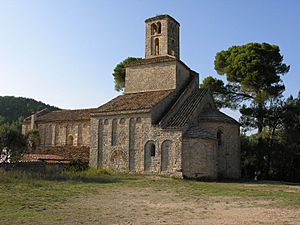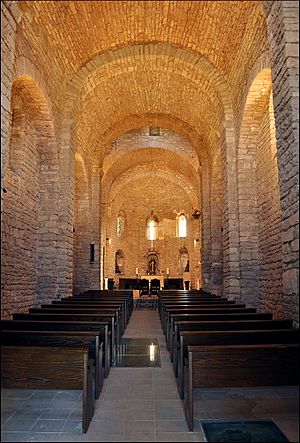Sant Ponç, Corbera facts for kids
Sant Ponç de Corbera is an old Benedictine priory located between the towns of Cervelló and Corbera de Llobregat. These towns are in the Province of Barcelona, which is part of Catalonia, Spain. This historic building was officially recognized as an important cultural landmark on June 3, 1931. Such a landmark is called a Bien de Interés Cultural in Spain.
Contents
History of the Priory
Early Beginnings
Sant Ponç de Corbera was first mentioned in official records in the year 1068. However, people believe that monks lived and worked in this spot much earlier than that. It seems the monastery was built between 1025 and 1050. It was ordered by a person named Guillem de Mediona, who came from Corbera.
Connections and Changes
By 1096, Abbot Salomó was in charge of the priory. At this time, Sant Ponç de Corbera was connected to a very important monastery called Cluny Abbey. This connection happened through another monastery in Spain, Sant Pere de Casserres.
Later, in 1590, Sant Ponç de Corbera joined a group of monasteries in the Tarragonés region. After that, it became part of the monastery of San Pablo del Campo. In 1835, a big change happened. The Spanish government took over many church properties. This event is known as the Ecclesiastical Confiscations of Mendizábal. Because of this, the priory was no longer run by the monks.
Becoming a Landmark
On June 3, 1931, the monastery was officially named a Bien de Interés Cultural site. This means it is a protected building because of its historical and artistic importance.
The Priory Building
Inside the Church
The main part of the building has a single long room, called a nave. The ceiling of this room is shaped like a half-cylinder, known as a barrel vault. The church also has a transept, which is like the arms of a cross shape. At the end of the church, there are three rounded sections called apses.
Outside Decorations
On the outside, these apses are decorated with arches and flat columns called pilasters. Two of the apses are connected by open doorways in their walls. The roof of the church has a small, square bell tower. This tower has windows on two levels.
Ancient Art and Statues
Inside the church, you can still see parts of old Roman wall paintings. These paintings show designs of plants. Other decorations include two plant stems linked together in a figure-eight shape. There are also images of a wolf and a bird with its wings spread open. On one of the apses, called the gospel apse, you can see more plant designs. These are part of a decorative band called a frieze. This particular decoration was added later than the original building.
Inside, there is also a colorful statue of the Virgin Mary. She is shown feeding baby Jesus. This type of statue is called the Virgin of the Llet. It was made around the 13th century. The building has been repaired and cleaned up several times, including in 1929 and 1992.
See also
 In Spanish: Monasterio de Sant Ponç de Corbera para niños
In Spanish: Monasterio de Sant Ponç de Corbera para niños
- History of medieval Arabic and Western European domes



